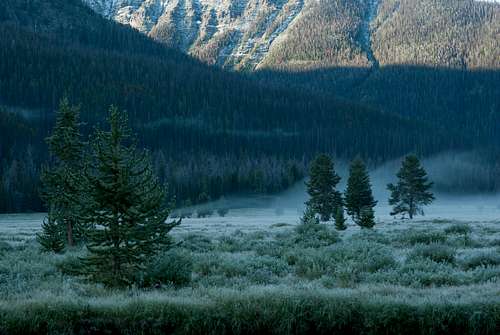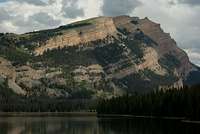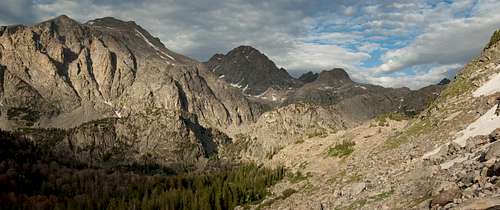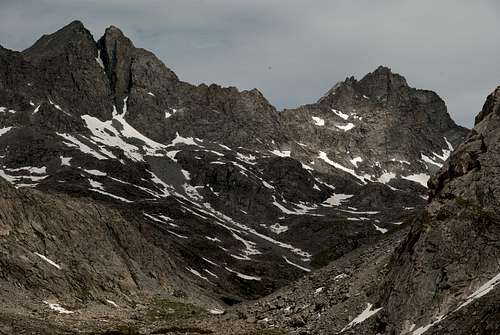Bill Reed - Sep 2, 2011 11:19 am - Voted 10/10
Great article!!Wyoming is indeed a special place with lots of wilderness opportunities. The Wind Rivers do seem to be the wildest of the wild. Just spent 9 days on the edges of some of it's darkest reaches and went 7 days without seeing another human being.
I'm thankful for the uniqueness of the Wind River Range that makes it the wild place it is and will be, hopefully forever. The fact that no roads cross it and that it's surrounded by the 3 Wildernesses you mentioned along with the Wind River Roadless Area give it a large buffer zone. So far it's been big enough.
If access was easier, it's spectacular beauty would be well known and it probably would have been made a National Park years ago. But it's not and that's a good thing. It seems a workable paradox thus far - huge TH parking lots in the most popular spots with crowds of people in Titcomb Basin and the Cirque of the Towers on one hand, and next to nobody one or two ridges away on the other. I love it!!
Thanks for putting it into words.
magicdufflepud - Sep 2, 2011 1:03 pm - Hasn't voted
Re: Great article!!Thanks, Bill!
You're right: I think you can solitude pretty much anywhere, so long as you search for it. Even in the Winds, heading off trail away from Titcomb, and I'm guessing the Cirque of the Towers, will take you away from the crowds. But compare those huge trailheads to those lining the Gros Ventre, the Absarokas and the Wyoming Range, and it becomes pretty clear that the Winds are the most popular of the bunch. Glad you got to spend some quiet time in heart of one of America's most beautiful ranges.
Bob Sihler - Sep 2, 2011 1:17 pm - Voted 10/10
YesI think you already know my feelings about Wyoming, and they closely match yours. True, the Winds have their crowded corridors, but the range is so vast that there are lots of great sections that see almost no human use. And if you need more solitude, you know you've got the Absarokas, the Gros Ventres, and the Wyoming Range. Why do I go to the Absarokas every year? You've pretty much explained why.
magicdufflepud - Sep 2, 2011 1:48 pm - Hasn't voted
Re: YesI've always enjoyed hearing your thoughts about Wyoming, Bob, and you're single-handedly responsible for introducing me to what have become some of my favorite parts of this country. But even though I think my feelings about wilderness have grown a little more nuanced over the years--away from that ideologically-charged hyperventilation when I first started visiting SummitPost--I'm still out there searching for those beautiful, empty places. Maybe we'll run into each other in one of them sometime.
Matt Lemke - Sep 5, 2011 9:37 am - Voted 10/10
North end...Spent 6 days in the northern end of this range and saw no one!
magicdufflepud - Sep 5, 2011 10:48 pm - Hasn't voted
Re: North end...Wow! You hit it right, then. I think this year may have concentrated a lot of the folks visiting since the high snow totals--it was a great ski season--barred access to most of the passes until early August. After that, I get the sense that most everyone descended on it at once.
magicdufflepud - Sep 6, 2011 1:37 pm - Hasn't voted
Re: Multi-useIn the Winds too? I had no idea. Back when I was a Midwesterner our chance encounter with a flock of sheep at 10,000' in the Wyoming Range really came as shock. Must be more sheep out there than I'd thought.
MoapaPk - Sep 9, 2011 6:01 pm - Voted 10/10
Yep.I can drive 15 minutes from Las Vegas, and hike to mountains that have very few entries in the registers. And I'm undoubtedly responsible for adding to the frequency of visitors, just by my web posts. That's why I never describe them on summitpost, and have stopped describing them on-line... but the cat is out of the bag.
aglane - Nov 25, 2013 9:43 am - Hasn't voted
supplementsSee also Jack Turner's books 'The Abstract Wild'--a series of essays arguing just how there has in fact been no 'wilderness' as we usually adopt the word in many a generation--and 'Travels in the Greater Yellowstone'--a strong case finely detailing the many threats to the ecosystem, with close attention to the Winds. From our best philosopher and climber of recent generations, and a guide who knows the area like few others.
MtnGuide - Nov 26, 2013 7:25 pm - Hasn't voted
To find fewer crowdsSki in.














Comments
Post a Comment